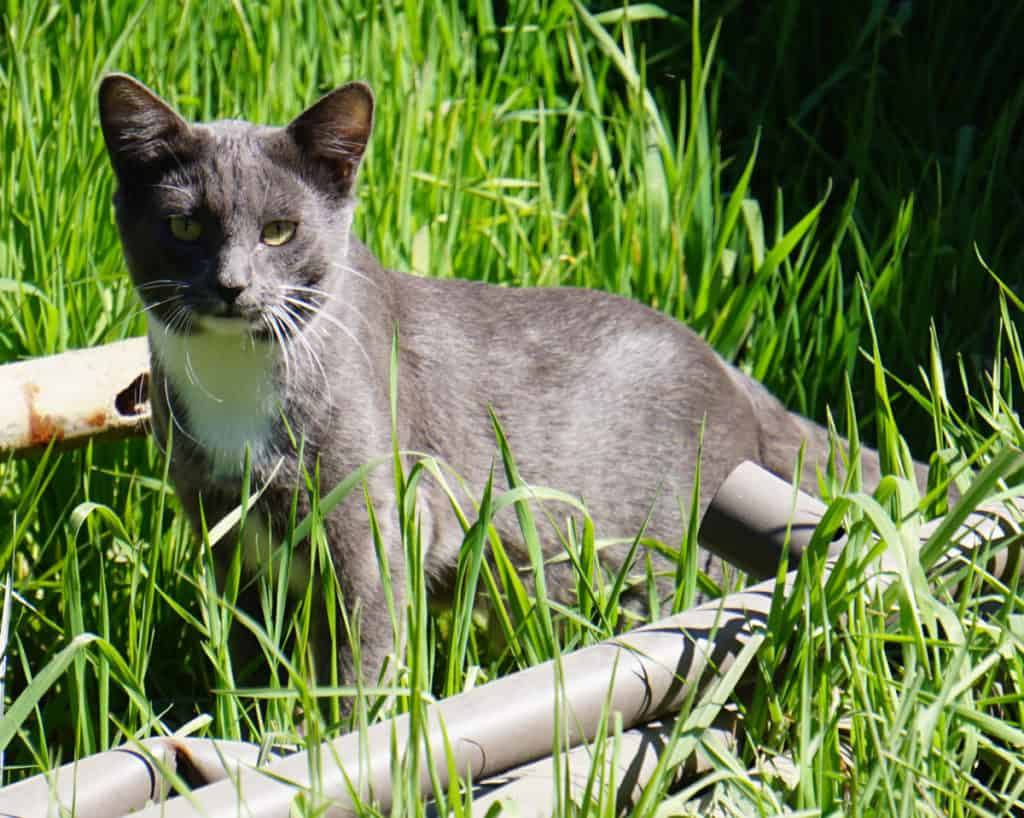All domestic cats are descended from Felis silvestris lybica, a small wild cat known as the Southwest Asian/ North African wildcat . All cats are in the family Felidae which first evolved about ten to eleven million years ago of which there are eight major phylogenetic lineages. The subspecies of African wildcat genetically diverged from a common ancestor about 2.16 to 0.89 million years ago.
About 10,000 years ago, the African wildcat was tamed in the Fertile Crescent and are considered the early ancestors of the domestic cat. The earliest evidence of tamed cats was unearthed from an early Neolithic site in Cyprus that datefs back about 9,500 years. Remains of cats were found buried with humans, indicating a domestic relationship with the felines.
Domestication continued during Ancient Egyptian times about 3,600 years ago as a symbiotic relationship evolved between people and cats. Cats were valued in Ancient Egypt as a way to protect grain stores. Most people associate the domestication of cats with the Ancient Egyptians.
Origins of the Domestic Cat
Recent research points to domesticated cats having descended from two distinctly separate events, but all domestic cats have their common ancestors in the Southwest Asian/ North African wildcat, Felis silvestris lybica.
Researchers recently published a study online in Nature Communications that discussed the origins of the domestic cat. After analyzing cat DNA (mitochondrial genome) from nine wildcats, 274 domestic cats, and 59 previously studied ancient mummies, they found out that domestic cat genetic diversity is limited to two maternal lineages: African and Middle Eastern.

Their analysis indicates that Egyptian cats carry more African lineages than any other population whereas European cats have more of what appears to be a combination of both African and Middle Eastern genetic heritage.
Cat Domestication in China
Another potential example of cat domestication may be traced to China, where J.D Vigne studied the relationship between humans and leopard cats living in two villages, 2016. Additional analysis of data from this study suggests that human-leopard cat relationships in these villages were more similar to modern domestic relationships rather than a common scavenger/human relationship.
It is important to note that the full extent to which these prehistoric Chinese “cats” were domesticated still needs further investigation for future findings.
In China, leopards were once domesticated independently of the rest of the world. However, there is no evidence that their domestication lasted or that any modern-day “domesticated” cat was domestically derived from them.
How the Domestic Cat Spread Around the World
According to Ottoni’s findings, cats spread around the world in a sort of interesting way. By analyzing ancient remains of cat samples and finding connections between relics found in port cities, scientists concluded that cats were brought along on ships and from city to city, originally most likely for protecting storages of food onboard with their killer hunting abilities and ability to kill rodents.
This hypothesis would bring about one explanation for how felines came to expand their range so broadly across the Earth.

Domestic Cats Divergence from the African wildcat
Today, the domestic cat and the Africa Wildcat have very few genetic differences. The major difference tends to be with the expressed coat pattern and temperament.
Domestic cats, for example, are usually small, social, and have a body language that most people can read. Even when raised as kittens in a human community, F.s. silvestris has a tendency to be very frightened and aggressive. The difference in temperament is attributed to genetics by scientists.
While some cats retain similar markings to their ancestors, many domestic cats have been bred to exhibit different coat patterns and colors.
The tabby pattern of the domestic cat is thought to have originated in Asia, and early tabbies were seen with solid coats, stripes, and even dots, each of which might represent more primitive ancestral forms. The blotched coat pattern seen in modern tabby cats may be a more recent development caused by environmental or artificial selection rather than having evolved from self-perpetuating wildcat populations.

Domestication of Cats
The domestic cat (Felis catus) is a direct descendant of the wildcat. During domestication from its close contact with humans, this particular species has not undergone major changes during the process and remains very similar in behavior and form to that of their close ancestors.
The domestic cat can be skilled at surviving under natural conditions, as some return to a feral existence when abandoned or lost by their owners.
Read next: When Did Cats Become Indoor Pets?
References
Kaelin, C. B., McGowan, K. A., & Barsh, G. S. (2021). Developmental genetics of color pattern establishment in cats. Nature communications, 12(1), 1-12. https://doi.org/10.1038/s41467-021-25348-2
Ottoni, C., Van Neer, W., De Cupere, B., Daligault, J., Guimaraes, S., Peters, J., … & Geigl, E. M. (2017). The palaeogenetics of cat dispersal in the ancient world. Nature Ecology & Evolution, 1(7), 1-7. https://doi.org/10.1038/s41559-017-0139
Ottoni, C., & Van Neer, W. (2020). The Dispersal of the Domestic Cat: Paleogenetic and Zooarcheological Evidence. Near Eastern Archaeology, 83(1), 38-45. https://doi.org/10.1086/707312
Vigne, J. D., Evin, A., Cucchi, T., Dai, L., Yu, C., Hu, S., … & Yuan, J. (2016). Earliest “domestic” cats in China identified as leopard cat (Prionailurus bengalensis). PloS one, 11(1), e0147295. https://doi.org/10.1371/journal.pone.0147295
Vigne, J. D., Guilaine, J., Debue, K., Haye, L., & Gérard, P. (2004). Early taming of the cat in Cyprus. Science, 304(5668), 259-259. DOI: 10.1126/science.1095335
Werdelin, L., Yamaguchi, N., Johnson, W. E., & O’Brien, S. J. (2010). Phylogeny and evolution of cats (Felidae). Biology and conservation of wild felids, 59-82.






